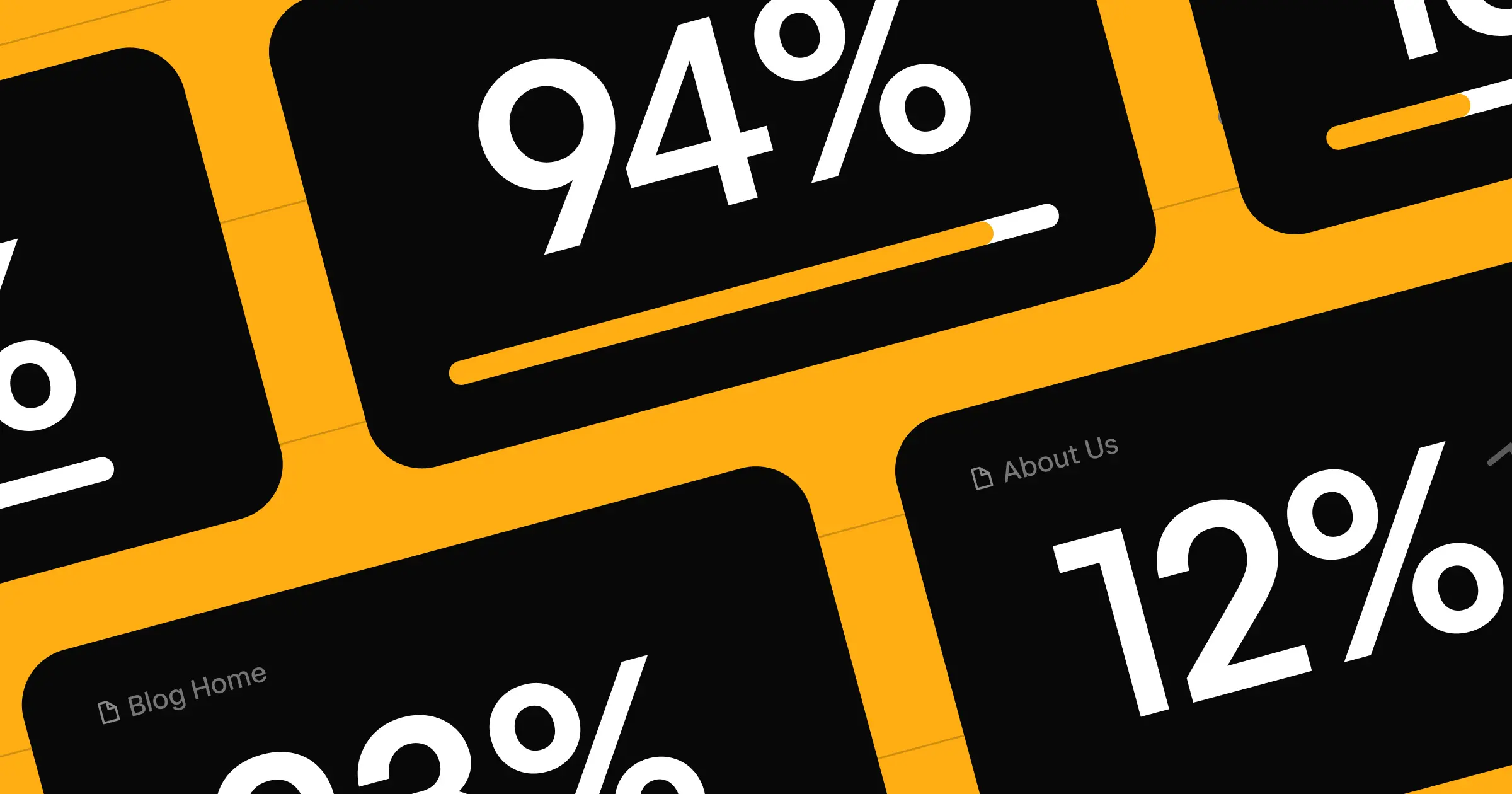Revolutionize your conversion strategy by identifying impactful clicks.
While every website interaction represents user engagement, not all lead to meaningful outcomes. To sift through and extract meaningful insights from these interactions, you need conversion analysis. It’s more than just a metric — it’s a compass that guides your team toward building a website that engages visitors and converts them into devoted customers.
Let’s take a closer look at website conversion analysis to extract actionable insights for design and marketing strategies.
What’s conversion analysis?
Conversion analysis delves into the conversion data of your website or platform and evaluates user interactions and how they translate into desired actions, like purchases or subscriptions. It analyzes the behavior, activities, and reasons behind a customer’s decision, whether abandoning a shopping cart or completing a purchase.
These insights identify customer pain points, areas of improvement, and successful conversion funnels to benchmark your website’s performance. This, in turn, provides data into how your team can refine marketing tactics and web design elements to reduce user friction and improve the user experience (UX), paving the way for more conversions.
Different types of customer conversions include:
- Sales conversion: A visitor browses an ecommerce website and finalizes a purchase
- Sign-up conversion: Users decide to sign up for newsletters, create accounts, or join memberships
- Download conversion: Users download something of value, such as an app, ebook, whitepaper, or other digital resources
- Click-through conversion: Users follow a call-to-action (CTA) button that redirects them to another page or prompts another interaction
3 main benefits of analyzing conversions
Customer conversion data lets you determine where your current strategies and website elements shine and falter so you can create a better site experience for your customers and optimize conversions.
Specific benefits of conversion funnel analysis include:
1. Efficient resource allocation
Even the most well-funded teams have finite resources, like time, personnel, and budget. Conversion reports provide essential data that can help you efficiently allocate those resources and improve your bottom line.
For example, when determining how much time and effort to allocate to various marketing channels — such as social media, search, and email — conversion reports become invaluable. They offer insights into the balance between the cost of acquiring a new customer and the value they bring throughout their lifetime with your business. This lets you assess the cost-effectiveness of gaining many new customers versus nurturing existing relationships. It also guides you in selecting the most efficient channel for customer outreach.
Analyzing this data makes your conversion strategy sharper because you can prioritize cost-effective customer acquisition while maximizing their potential long-term value. For example, conversion analysis reports might reveal that customers earned through social media ads not only cost less to acquire but also tend to make more repeated purchases, in contrast to those reached through email marketing. Use this data to inform your customer success strategy.
2. Optimized customer navigation
Conversion funnel analysis lets you explore customer data to pinpoint areas of friction in the customer journey that cause customers to drop off. If you’ve crafted a captivating ecommerce website but discover customers abandoning their cart before finalizing their purchase, conversion analysis helps you detect the exact stages where customers lose interest and exit your site. In this case, it might reveal that an unintuitive payment process frustrates customers, causing them to leave.
By addressing these identified pain points, such as streamlining the checkout process in this example, you reduce your bounce rate, minimize cart abandonment, and enhance the overall conversion rate. This optimization boosts sales and ensures a smoother user experience, building customer trust and loyalty.
3. Enhanced customer experience
Draw on conversion analysis data to refine your marketing, design, and web strategies and ensure they resonate more effectively with their target audience and achieve set objectives. Offering genuine value for your customers boosts user engagement and reduces customer churn by enhancing user satisfaction.
For example, imagine you have a B2B website specializing in customer relationship management (CRM) software. Through conversion analysis, you discover that many website visitors are interested in integrations with other popular business tools. Acting on this information, you strategically pepper your site with CTAs promoting integration-related resources and webinars. This proactive approach leads to a notable increase in sign-ups for your integration-focused webinars, demonstrating a successful conversion strategy.



















Build a better site experience
In our ebook, learn how to approach your next website redesign — from collaboration and trust-building to finding the right tools.
How can I analyze conversion rates?
The conversion rate formula plays an integral part in conversion analysis. To determine your conversion rate, use this formula:
Conversion rate =(Number of conversions / Total visitors) x 100
But conversion analysis is much more than calculating conversion rate. Beyond this metric, it also dives deeper into understanding the nuances of customer behavior.
While each situation differs, here’s a brief guide to help you navigate conversion analysis.
1. Define your conversions
Start by defining what constitutes a conversion for your website, whether this means purchases, click-throughs, sign-ups, or downloads. This definition hinges on your business goals. For instance, if you’re running an ecommerce site, you’ll likely define conversions as purchases.
2. Segment your customers
Categorize users based on factors such as demographics, behavior, or geographic location. Then, analyze the conversion data for each segment to understand why specific segments drop off at particular stages of the customer journey or why other groups tend to convert more often. This allows for targeted strategies and lets you address each group’s unique needs, preferences, and behaviors to drive more efficient and effective conversions.
3. Collect data and reports with analytics tools
After defining your conversions, track them. You can do this by setting up your website’s analytics and targeting tools or using powerful, third-party solutions like Google Analytics. These tools monitor specific events like button clicks or form submissions to provide a granular, data-driven understanding of user behavior.
However, raw conversion data alone isn’t actionable. After collecting conversion data, you must transform it into comprehensive reports and visualizations, like conversion heatmaps. These visual aids aggregate and interpret customer data, producing actionable data and enabling more informed decision-making. Fortunately, most analytics tools have built-in reporting functionalities to provide a streamlined and insightful process.
How to use extracted insights from your conversion analysis
The real impact of conversion rate analysis comes from leveraging those insights to fine-tune your overall strategy to increase conversions, a process known as conversion rate optimization (CRO). Here’s how to make the most of your conversion analysis.
1. Identify bottlenecks
Bottlenecks, or roadblocks, are customer journey sections where visitors experience friction and, as a result, drop off. Conversion analysis identifies and lets you rectify these interruptions so you can pave the way for streamlined conversions. For instance, customers might feel overwhelmed by complex webpage design, confusing product descriptions, or poor site performance due to server issues.
Addressing these pain points, like optimizing server response or simplifying site layouts, can significantly improve user satisfaction. This drives successful conversions and cultivates a positive and memorable user experience, encouraging repeat visits and brand loyalty.
2. Refine your conversion strategy
Conversion analysis insights provide a treasure trove of actionable insights. Tap into this data to adjust your online web content and align it with proven conversion drivers. For example, if analysis reveals that users engage more with video content than infographics, consider creating product demonstration or customer testimonial videos. If certain keywords or topics resonate more with your target audience, produce content around those themes to attract and retain visitor interest. By adapting to audience preferences and behaviors, you more effectively captivate and guide them through the conversion funnel.
3. Test and iterate
Successful CRO strategies require ongoing attention and refinement. While conversion analysis provides data to refine your strategy, you’ll still need to continuously test and iterate on your approach to ensure it serves your audience.
For instance, before committing to a new marketing strategy, use A/B testing tools to validate your conversion analysis findings by comparing the performance of your current approach against the proposed changes. This lets you trial different landing page variations, pricing strategies, marketing campaigns, and more. Once you implement your new strategy, conduct another conversion analysis to see if you’re on the right track. This continuous feedback loop informs further strategy and web content tweaks and ensures your tactics evolve with your audience’s preferences.
Start converting now with Webflow
Ready to elevate your website’s performance and turn casual visitors into dedicated customers? We’re here to help.
Webflow’s intuitive design tools, combined with powerful analytics tools, empower you to craft engaging user experiences with captivating layouts and seamless interactions that drive conversions. In fact, you can even hook up your Webflow website to Google Analytics to take advantage of this powerful conversion analysis tool. Build a website with Webflow today.
































